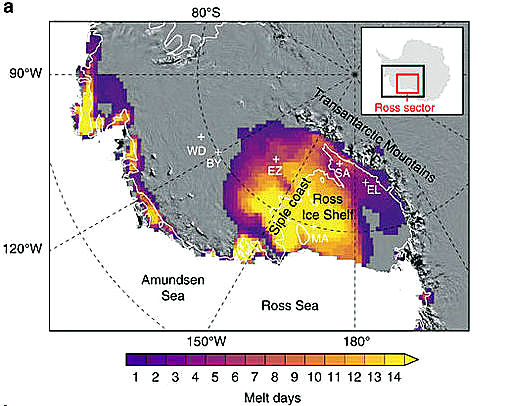Raining In Antarctica
Waterfalls on Nansen ice sheet, West Antarctica (credit: YouTube)
In a polar desert, it is not supposed to rain. However, in Antarctica it has now been recorded along with massive waterfalls flowing off of an ice sheet. Writing in Nature Communications, researchers from the Scripps Institute of Oceanography in California and the University of Ohio report:
"extensive and prolonged surface melting in the Ross Sea sector of the West Antarctic Ice Sheet. The unusual extent and duration of the melting was linked to strong and sustained movement of warm air toward the area. Our observations highlighted the presence of low-level, liquid-water clouds, which may have aided the heating of the snow surface."

Ross Ice Sheet Melt Days, January 2016 (credit: Nature Communications)
The Nature study used data gathered by NASA's Cloud-Aerosol Lidar and Infrared Pathfinder Satellite Observation (CALIPSO) mission that showed rain clouds widespread over West Antarctica in January 2016. The clouds were linked to an el Nino then in progress and recorded by the number of "melt days" measured: "Data from January 12, 2016 suggest that rain fell over parts of the Ross Ice Shelf at the beginning of the (melting) event which may have pre-conditioned the snow surface for prolonged melting."
As with most environmental research, more questions were raised than answered by these observations. In their conclusions, the authors offered opposing predictions for the future of the West Antarctic Ice Sheet (WAIS):
"two recent modeling studies have come to different conclusions about the future evolution of surface melt over the Ross Ice Shelf and its impact on the WAIS. One study suggests that the phenomenon will remain minimal throughout the twenty-first century. The other projects that the Ross Ice Shelf will experience extensive surface melt and retreat substantially by 2100. In this context, the extent to which the January 2016 event is a precursor of the climate of West Antarctica in the coming decades is uncertain. Our study highlights some key mechanisms that need to be resolved to address this question."
Stay tuned!
WHB